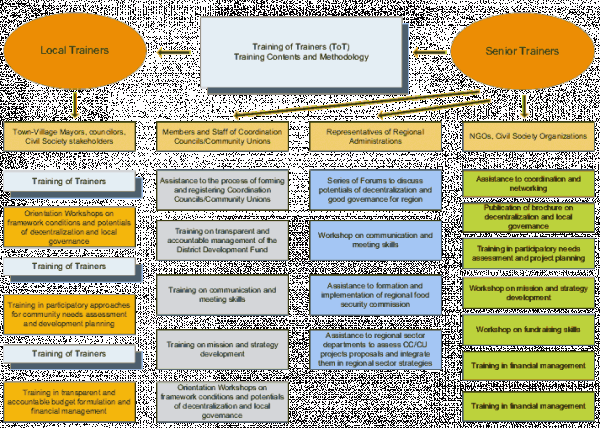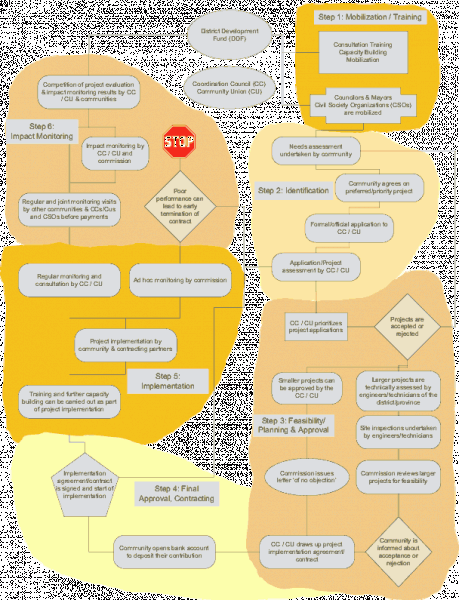Development Funds - Example: District Development Fund, South Caucasus
 |
Background
|
 |
Seven main principles and steps to establish the District Development Fund are:Step 1: Development of a manualDefining the general objective(s), institutional principles, organisational procedures for the fund. Furthermore eligible sub-projects and targeted groups of the fund are defined.1.1 General objectives:The District Development Fund is a financial instrument to contribute to food security and poverty alleviation by financing small-scale projects that benefit the needs segments in the district. The Fund also contributes to community capacity building and to the coordination of development activities in the district. More specifically the fund addresses the needs of the poor and poorest in terms of:
1.2 Institutional principles:Transparency:A clear set of rules accompanied by a public monitoring and auditing system will protect food security and poverty-relevant spending against corruption. By ensuring that all community members are informed about the development project activities, budget and status of implementation greater public accountability will be achieved. Efficiency:
The fund is open to all communities and Community Union (CU) members. A “Food Security Screening and Approval Commission” made up of representatives from the Community Unions, the Marzpeteran (Provincial administration) and the donor organisations contributing to the fund. The administrative, technical and financial autonomy to regulate its operations. The Fund is subject to regular public audits. The CU administers and monitors the fund at regional level. Eligibility: The DDF will promote and finance through grants the establishment and rehabilitation of basic socio-economic development projects and social services, including income and employment generation activities. All activities are based on the needs of local population and meet the following key criteria:
|
|
|
Step 2: Capacity buildingPromotion of cooperation and participatory processes at different levels of government in the region is of major importance for the fund. Therefore FRCS provides a broad capacity building scheme that targets local communities, municipalities, regional authorities as well as NGOs. Training for communities is related to general project management (mobilisation skills, organisation of community groups, project identifications, planning and implementation, communal savings and loan schemes, etc.) and to food security, employment and/or income generation. Figure 1: Process for capacity building, including training of trainers
|
Step 3: Project identificationThe CU inform local communities about the fund, how the communities can request projects and selection criteria, conditions for financing (financial contribution from communities), maintenance obligations, etc. A public meeting is held to prioritise the projects they wish to apply for. Project proposals are written by the community mayor and approved by the councillors. Proposals are submitted including Minutes of Meeting to the Community Unions. Step 4: Project assessmentThe CU assesses the project proposals and prioritises them according to defined criteria in the manual. Projects up to an amount of US $ 5000 can be approved by the CU. Projects exceeding that amount are submitted to the “Food Security Screening and Approval Commission”. If within 14 days no letter of objection is received the project is deemed as having been approved. Table 1 provides an example of the project selection process. Step 5: ContractAfter project approval the contract between parties is concluded. The contract includes a maintenance and operation plan. Responsibilities for procurement, supervision, modes of payment and handing over are defined. If applicable and in accordance with the plan, a maintenance fund, managed by the community group, may be established to finance the daily operating costs and maintenance costs on an annual basis. Table 1: Example of criteria to be applied for project selection Step 6: Implementation monitoringCommunity Union assesses the output produced and the progress with regard to achieving the main objectives. Key performance indicators have been developed for measuring the achievements. Internal audits are also undertaken. Step 7: Post monitoring and evaluationAt the micro level, post evaluation is carried out on focal community groups between 3 and 6 months after the project’s end. At the macro level, impact evaluation takes place one year after completion of a significant project component. |
|
 |
Figure 2: Process for accessing the District Development Fund
|


